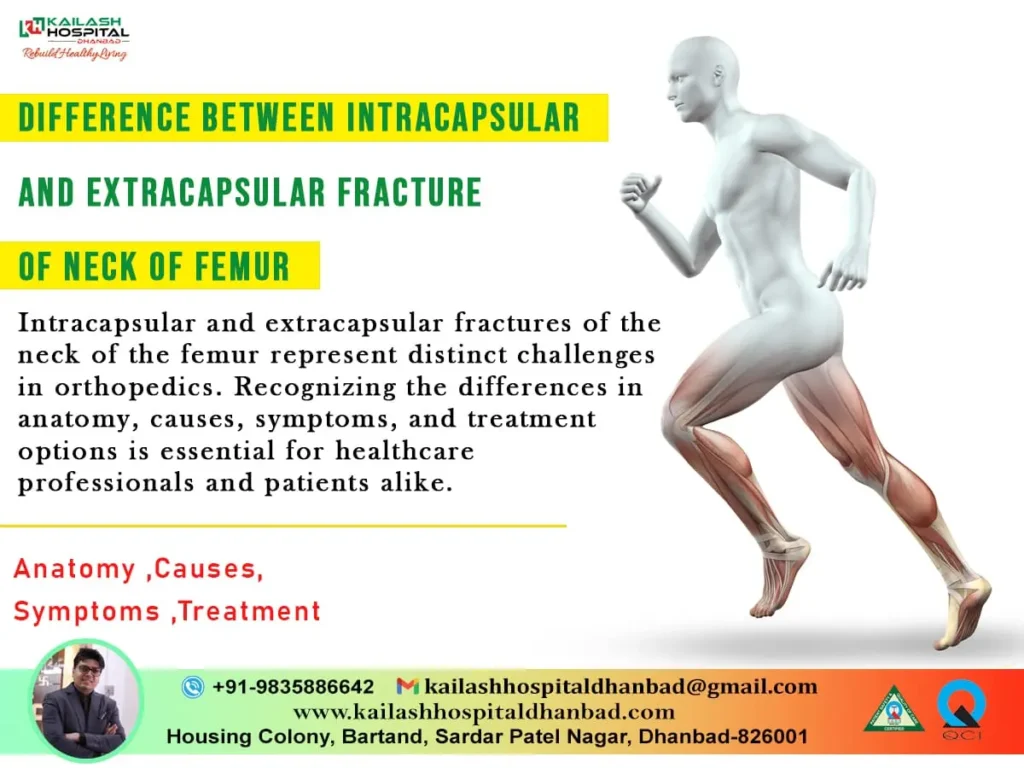
Table of Contents
Intracapsular and extracapsular fracture
Fractures are common injuries that can affect various parts of the body, and one specific type that often requires careful attention is an intracapsular fracture. In this blog post, we will explore what intracapsular fractures are, their causes, symptoms, and the available treatment options.
Intracapsular fracture:
What is an Intracapsular Fracture?
An intracapsular fracture refers to a break that occurs within the joint capsule, the protective tissue surrounding a joint. Joints, such as the hip, are encapsulated by a synovial membrane, forming a capsule that contains synovial fluid, which lubricates and nourishes the joint.
Causes of Intracapsular Fractures:
1. Trauma : High-energy trauma, such as a car accident or a fall from a significant height, can lead to intracapsular fractures. The force applied to the joint can cause the bone to break within the joint capsule.
2. Osteoporosis : Weakening of bones due to conditions like osteoporosis increases the risk of fractures. Intracapsular fractures, particularly in the hip, are more common in individuals with brittle bones.
3. Age : Older adults are more susceptible to it due to a combination of factors, including reduced bone density and a higher likelihood of falls.
Symptoms of Intracapsular Fractures:
1. Pain : Intense pain at the site of the fracture is a common symptom. The pain may be exacerbated by movement or putting weight on the affected joint.
2. Swelling and Bruising : Swelling and bruising around the joint may occur due to the trauma that led to the fracture.
3. Limited Range of Motion : It can restrict the normal range of motion in the affected joint. This limitation is often noticeable when trying to move the joint.
Treatment Options:
1. Non-Surgical Management : In some cases, non-surgical approaches may be considered, especially for less severe intracapsular fractures. This may involve rest, pain management, and physical therapy to improve joint function.
2. Surgical Intervention : Severe intracapsular fractures, particularly those affecting the hip, may require surgical intervention. Procedures like internal fixation (using screws or pins to stabilize the fracture) or joint replacement may be recommended.
3. Rehabilitation : Regardless of the chosen treatment, rehabilitation is crucial for restoring strength and mobility. Physical therapy and exercises help patients regain function and prevent complications.
Intracapsular fractures pose unique challenges due to their location within the joint capsule. Prompt diagnosis and appropriate treatment are essential for optimal recovery. If you suspect an intracapsular fracture or experience symptoms, consult a healthcare professional for a thorough evaluation and personalized treatment plan. Understanding the causes, symptoms, and treatment options can empower individuals to make informed decisions about their health and well-being.
Extracapsular fracture:

What is an Extracapsular Fracture?
An extracapsular fracture occurs when a bone breaks outside the joint capsule, which is the tough, fibrous tissue that surrounds the joint. This type of fracture commonly affects long bones such as the femur and humerus. The extracapsular nature of these fractures distinguishes them from intracapsular fractures, where the break occurs within the joint capsule.
Causes of Extracapsular Fractures:
Several factors can contribute to the occurrence of extracapsular fractures, including:
a. Trauma: High-impact accidents, falls, or sports injuries can lead to extracapsular fractures.
b. Osteoporosis: Weakening of bones due to conditions like osteoporosis increases the risk of fractures, including extracapsular fractures.
c. Age: Older individuals are more susceptible to fractures due to changes in bone density and strength.
Symptoms of Extracapsular Fractures:
Identifying the signs of an extracapsular fracture is crucial for prompt diagnosis and treatment. Common symptoms include:
a. Pain: Intense pain at the site of the fracture, aggravated by movement.
b. Swelling: Inflammation and swelling around the injured area.
c. Deformity: Visible deformity or misalignment of the affected limb.
d. Limited Mobility: Difficulty in moving the affected joint or limb.
e. Bruising: Discoloration or bruising may appear around the fracture site.
Diagnosis:
To diagnose an extracapsular fracture, medical professionals typically use a combination of imaging studies, such as X-rays or MRI scans. These tests help determine the location, extent, and severity of the fracture, guiding the appropriate course of treatment.
Treatment Options:
The treatment of extracapsular fractures depends on various factors, including the location and severity of the fracture, as well as the patient’s overall health. Common treatment options include:
a. Immobilization: Casting or splinting to stabilize the fracture and promote healing.
b. Surgical Intervention: In some cases, surgery may be necessary to realign and secure the fractured bones using screws, plates, or other fixation devices.
c. Rehabilitation: Physical therapy plays a crucial role in restoring mobility and strength after the initial healing phase.
Recovery and Rehabilitation:
Recovery from an extracapsular fracture is a gradual process. Following the prescribed treatment plan, attending rehabilitation sessions, and maintaining a healthy lifestyle contribute to a successful recovery. Patients are encouraged to follow their healthcare provider’s advice for a full return to normal activities.
Extracapsular fractures pose significant challenges, but with timely diagnosis and appropriate treatment, individuals can achieve a successful recovery. Understanding the causes, symptoms, and treatment options empowers both patients and healthcare professionals in managing these fractures effectively. If you suspect an extracapsular fracture, seek prompt medical attention for a comprehensive evaluation and personalized care plan.
Difference between intracapsular and extracapsular fracture of neck of femur

In this blog post, we will delve into the differences between intracapsular and extracapsular fractures, exploring their anatomy, causes, symptoms, and treatment options.
Anatomy: The femoral neck is a short, constricted segment between the femoral head and the greater trochanter. Understanding the anatomy is essential to comprehend the implications of intracapsular and extracapsular fractures.
Intracapsular Fractures:
- These fractures occur within the joint capsule of the hip.
- Commonly associated with the blood supply to the femoral head, making them more prone to complications like avascular necrosis.
- Subtypes include subcapital and transcervical fractures.
Extracapsular Fractures:
- These fractures occur outside the joint capsule.
- Usually located at the intertrochanteric or subtrochanteric regions of the femur.
- Tend to have a better blood supply, reducing the risk of avascular necrosis.
Causes: Understanding the causes of intracapsular and extracapsular fractures helps in recognizing risk factors and implementing preventive measures.
Intracapsular Fractures:
- Often associated with low-energy trauma in elderly individuals, such as a fall from standing height.
- Osteoporosis increases susceptibility to these fractures.
Extracapsular Fractures:
- Frequently caused by high-energy trauma, such as a car accident or a fall from a significant height.
- Osteoporosis can also contribute to the risk of extracapsular fractures, though less commonly than with intracapsular fractures.
Symptoms: The symptoms of intracapsular and extracapsular fractures can be similar but understanding the nuances is vital for accurate diagnosis.
Intracapsular Fractures:
- Groin or hip pain.
- Limited range of motion.
- External rotation of the leg.
Extracapsular Fractures:
- A pain in the area of the thighs or hips.
- Difficulty or incapacity to support weight on the limb that is injured.
- External rotation of the leg.
Treatment: The choice of treatment depends on several factors, including the type of fracture, patient age, and overall health.
Intracapsular Fractures:
Surgical intervention, such as internal fixation or hip replacement, is often necessary to minimize complications.
Extracapsular Fractures:
- Surgical options, including the use of intramedullary nails or plates and screws, are commonly employed.
- External fixation may be considered in certain cases.
Intracapsular and extracapsular fractures of the neck of the femur represent distinct challenges in orthopedics. Recognizing the differences in anatomy, causes, symptoms, and treatment options is essential for healthcare professionals and patients alike. A comprehensive understanding of these fractures contributes to improved diagnosis, better-informed treatment decisions, and ultimately, enhanced patient outcomes.



